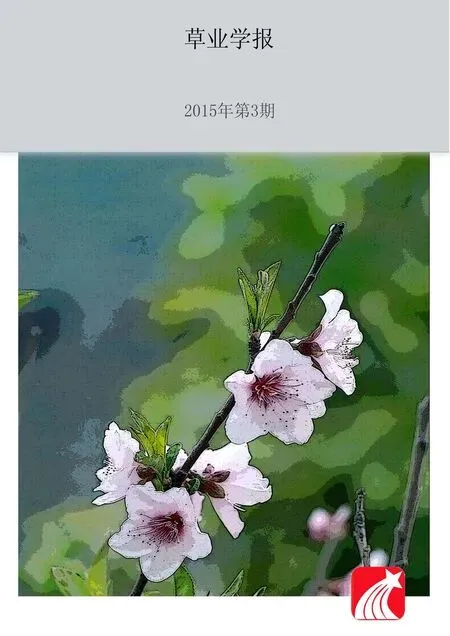白茅解剖结构和屏障结构特征研究
杨朝东,李守峰,邓仕明,姚 兰,袁龙义,张 霞*
(1.长江大学园艺园林学院,湖北荆州434025;2.湖北省保康县林业局,湖北保康441600;3.湖北民族学院林学园艺学院,湖北恩施445000)
白茅解剖结构和屏障结构特征研究
杨朝东1,李守峰2,邓仕明3,姚 兰3,袁龙义1,张 霞1*
(1.长江大学园艺园林学院,湖北荆州434025;2.湖北省保康县林业局,湖北保康441600;3.湖北民族学院林学园艺学院,湖北恩施445000)
利用光学显微镜和荧光显微镜对白茅进行了解剖学和组织化学研究,结果表明:1)白茅不定根解剖结构为表皮、外皮层、厚壁机械组织层、皮层、内皮层和中柱;根茎结构为角质层、表皮、周缘厚壁机械组织层、皮层、厚壁机械组织层和髓。2)不定根具内侧内皮层及其邻近皮层细胞、外侧表皮和皮下层组成的屏障结构;根茎具内侧厚壁机械组织层、外侧角质层和周缘厚壁机械组织层组成的屏障结构,屏障结构胞壁具凯氏带、木栓质和木质素沉积的组织化学特点。3)白茅通气组织包括根中通气组织,茎皮层通气组织和维管束中的气腔。4)白茅的屏障结构和解剖结构是其适应湿地环境的重要特征,但是根茎周缘厚壁机械组织层没有栓质化,髓部没有髓腔,推测其在湿地环境中分布有一定的局限性。
白茅;解剖结构;质外体屏障结构;组织化学;通气组织
白茅(l mperata cylindrica)为禾本科白茅属植物,广泛分布于我国,包括干旱和湿地区域,具有极强的营养繁殖和种子繁殖能力;地下根茎发达,固土作用强;根茎入药称白茅根。文献中仅报道了能适应干旱和湿地环境的芦苇(Phragmites australis)和狗牙根(Cynodon dactylon)等少数植物种类的解剖和屏障结构[1-3],白茅的解剖结构和屏障结构尚未报道。
经典植物形态解剖学主要强调组织器官等的构造,在植物分类学和系统学等研究中仍具重要地位[4-6],但很少研究细胞组织的发育过程和组织化学定位等。根据近年来根尖细胞发育生物学及其分子生物学研究进展[7-11],支持2001年Hose等[12]建议根的外皮层结构必须具备凯氏带,凯氏带部位细胞膜先有凯氏带膜蛋白家族出现,随后才有木质素和木栓质沉积[8-11],因此凯氏带化学组成包含蛋白质、木质素和木栓质。根中内皮层具凯氏带已被广泛接受,作者建议内皮层和外皮层应视作植物体内特殊结构,而且不等同于传统意义上认为分别是皮层结构的一部分。皮下层指表皮下细胞层有形态学和胞壁的组织化学分化,以水稻(Oryza sativa)、芦苇根尖为例,是单层或多层细胞外皮层和其下厚壁机械组织层分化前和分化后的统称[1-2,7,13]。皮层的细胞壁没有组织化学的分化,仅为具初生壁的薄壁细胞[14]。例如,水稻根尖结构依次应称为:中柱、内皮层、皮层、皮下层(厚壁机械组织层和外皮层)和表皮。如果皮下层无厚壁机械组织层,凯氏带出现前仍称皮下层,具凯氏带之后即称为外皮层。同时也建议植物茎、叶和花柄具凯氏带分化的部位也应视作特殊结构。
湿地植物的通气组织和质外体屏障结构是其适应湿地环境的重要结构[15-20]。通气组织为植物在湿地缺氧环境下输导和储藏氧气[15-18];屏障结构的组织化学特征为植物初生壁的凯氏带,次生壁栓质化和木质化,体表角质层组成,屏障结构是植物控制植物内部以及与环境的水、离子和氧气扩散和交换的保护组织[19-20]。例如,水稻在静止溶液培养条件下,促进了根内、外皮层细胞壁栓质和木质素沉积的提早和增加,更有效的阻碍离子透过[13]。狗牙根和芦苇等的解剖结构和屏障结构的组织化学存在一定的差异[2-3,21-23]。这说明物种不同和同一物种生长的环境不同会影响屏障结构的组织化学和发育过程。研究白茅的解剖结构和屏障结构的组织化学特征,为了解湿地植物形态结构建成提供线索。
1 材料与方法
于2012年8月,自湖北荆州长江大学西校区附近湿地环境中采白茅野生植株,用自来水洗净,剪取长约18 cm的不定根,用福尔马林—醋酸—酒精固定液固定待用。白茅的茎以地下根茎为主,在顶端长出地上叶时才弯曲向上生长仅到达地面。本文采取白茅根茎未长出地上叶之前、每节具鳞叶的根茎。根茎长约50 cm,具有11~15个节,采用新鲜材料。实验重复5次。
在立体解剖镜下,用双面刀片分别距根尖10,30,50,70 mm和根基部以及根茎第1节间和第8节间切片。采用硫氢酸黄连素—苯氨兰对染切片检测细胞壁木质化和凯氏带[24](凯氏带呈现生动黄色,木质化细胞壁呈现呆滞黄色)。0.1%(w/v)硫酸氢黄连素溶液的配制:称取0.1 g硫酸氢黄连素溶于100 m L蒸馏水,震荡混匀待用。0.5%(w/v)苯胺兰溶液的配制:称取0.5 g硫酸氢黄连素溶于100 m L蒸馏水,震荡混匀待用。FeCl3—甘油缓冲液的配制:0.1%(w/v)FeCl3的配制,称取0.05 g硫酸氢黄连素溶于50 m L蒸馏水,搅拌混匀过滤,后与甘油等体积混合,室温保存待用。
染色过程:切片浸没于0.1%(w/v)硫酸氢黄连素溶液1 h后,用蒸馏水洗净,滴加0.5%(w/v)苯胺兰溶液0.5 h后,用蒸馏水洗净,后滴加一滴蒸馏水,盖上盖玻片。若等待长时间后才能观察,则滴加一滴FeCl3—甘油缓冲液。切片在荧光显微镜(Olympus IX71)蓝色激发光下观察,用数码相机(RZ200C-21,China)拍照记录图片。
0.1 %(w/v)苏丹红7B溶液染色切片确定细胞壁栓质化的组织化学定位[25](呈现红色)。0.1%(w/v)苏丹红7B溶液配制:称取50 mg苏丹红7B溶于25 m L PEG-300,后90℃水浴1 h并冷却,加入等体积90%甘油,室温保存待用。
染色过程:切片组织如有后含物用蒸馏水洗切片,用吸水纸吸净,后浸没于0.1%(w/v)苏丹红7B溶液1 h或过夜。切片用蒸馏水洗几次,用吸水纸吸净,后滴加一滴蒸馏水,盖上盖玻片,切片在莱卡光学显微镜(LeicaDME)下观察,用数码相机(Nikon E5400,Japan)拍照记录图片。图片主要用Photoshop 7.0软件处理,加标尺,调整图片亮度和对比度,以及合成图片等[3]。
2 结果与分析
2.1 不定根的解剖结构和组织化学
距白茅根尖10 mm,大部分内皮层细胞壁出现凯氏带,仅少数细胞为通道细胞。表皮细胞具扩散状栓质层,或部分已经脱落。表皮下为皮下层,由含凯氏带的单层细胞外皮层和轻微木质化数层细胞的厚壁机械组织层组成,或部分厚壁机械组织层细胞壁已强烈木质化(图1A)。同时,内、外皮层栓质化,皮层开始出现通气组织(图1B)。
距根尖30和50 mm,内皮层胞壁都具有凯氏带,皮下层胞壁进一步栓质化和木质化,表皮细胞几乎脱落(图1C,D)。距根尖70 mm,内皮层开始“U”形木质化增厚,内皮层邻近的几层皮层细胞栓质化;皮下层具较强烈的栓质化和木质化,皮层细胞几乎完全溶解形成通气组织(图1E,F)。根基部距根尖150 mm,内皮层完全“U”形木质化增厚,栓质层在“U”形木质层外侧。内皮层邻近1~2层皮层细胞木质化加厚;皮下层完全木质化增厚(图1G,H)。
白茅不定根的中柱,在中柱鞘内分别具有15~18束相间散生排列的原生木质部和原生韧皮部,5~7束后生木质部。距根尖10 mm髓部细胞开始木质化,随后直到根基部都完全强烈木质化(图1A,C,E,G)。
白茅不定根解剖结构由外而内依次为表皮、外皮层、厚壁机械组织层、皮层或溶解为通气组织、内皮层和中柱。其质外体屏障结构包括两部分,一是内侧具有凯氏带、栓质化和木质化的内皮层,及其邻近1~2层栓质化和木质化的皮层细胞;二是外侧的表皮和皮下层,表皮具栓质层,具有凯氏带、栓质化和木质化外皮层,具有栓质化和木质化厚壁机械组织层。
2.2 根茎的解剖结构和组织化学
白茅根茎幼茎的解剖结构自外向内依次由表皮外角质层,表皮,皮层,皮层具维管束,具维管束的厚壁机械组织层,靠近厚壁机械组织层的内侧有散生维管束,最内部为髓构成,厚壁机械组织层上及其内部的维管束有气腔(图2A)。老根茎表皮下出现周缘厚壁机械组织层,并木质化。皮层部分细胞溶解形成通气组织。木质化厚壁机械组织层外侧的一层细胞栓质化,并呈“U”形木质化加厚。皮层维管束没有气腔,而厚壁机械组织层上及其内部的维管束气腔增大,周围机械组织强烈木质化(图2B,C,D)。
白茅根茎解剖结构由外向内依次为:角质层、表皮、周缘厚壁机械组织层、皮层、厚壁机械组织层和髓。通气组织包括皮层通气组织和维管束中气腔。根茎的质外体屏障结构为,一是外侧角质层和表皮下木质化周缘厚壁机械组织层;二是木质化的厚壁机械组织层及其外侧栓质化的一层细胞。
3 讨论
3.1 白茅的解剖结构和屏障结构
白茅不定根解剖结构由外而内依次为表皮、外皮层、厚壁机械组织层、皮层、内皮层和中柱。白茅中柱由散生原生木质部和原生韧皮部、后生木质部和髓部组成,与禾本科常见玉米(Zea mays)、小麦(Triticum aestivum)等类似。单细胞层的内皮层和外皮层与水稻和水甜茅(Glyceria maxima)相同,它们的组织化学形成有类似的发育历程[2,13];但狗牙根和芦苇等的外皮层为多层细胞[3,13]。白茅不定根与菰(Zizania latifolia)、狗牙根和双穗雀稗(Paspalum distichum)等都有内皮层邻近1~2层栓质化和木质化的皮层细胞[3,21]。与水稻、菰、芦苇等都有类似的厚壁机械组织层[2-3,13,21],与水稻、菰、双穗雀稗和牛鞭草(Hemarthria altissima)的表皮细胞都有栓质层[3,13,21]。这些说明白茅不定根内侧的内皮层及其邻近皮层细胞的质外体屏障,外侧的表皮和皮下层质外体屏障所组成的屏障结构与其他适应湿地和干旱环境的植物具相似屏障结构。
白茅根茎解剖结构由外向内依次为角质层、表皮、周缘厚壁机械组织层、皮层、厚壁机械组织层和髓。玉米等常见禾本科植物茎内维管束散生于皮层薄壁细胞中,而白茅根茎与狗牙根等茎的表皮下的周缘厚壁机械组织层、皮层、具维管束的厚壁机械组织层和最内部的髓。不同点在于白茅和假俭草(Eremochloa ophiuroides)茎的周缘厚壁机械组织层仅木质化,而其他植物茎的则栓质化和木质化,而且双穗雀稗茎具有内、外皮层。此外,菰茎的厚壁机械组织层仅栓质化,白茅和狗牙根的厚壁机械组织层外侧有层细胞栓质化[3,21-22]。白茅和假俭草茎外侧仅有角质层和木质化周缘厚壁机械组织层,推测它们可能适应湿地环境能力要差些。
狗牙根和双穗雀稗等植物根、茎皮层和髓部中都有发达的通气组织,白茅的根有通气组织,茎皮层中的通气组织不太发达,茎的维管束具气腔,而髓没有溶解形成髓腔,因此白茅体内具有一定的通气组织,但体内气腔总容积相对有限[3,21]。
3.2 白茅的湿地环境适应性
根据白茅的屏障结构和解剖结构特点,白茅不定根内侧和外侧具完备的屏障结构,根茎外侧具角质层和木质化周缘厚壁机械组织层,不定根和茎皮层有通气组织是其适应湿地环境的重要结构特征。但是白茅根茎周缘厚壁机械组织层没有栓质化,髓部没有形成髓腔而气腔容积相对有限,推测其在湿地环境中生长和分布有一定的局限性。
Reference:
[1] Soukup A,VotrubováO,ĈížkováH.Development of anatomical structure of roots of Phragmites australis.New Phytologist,2002,153:277-287.
[2] Soukup A,Armstrong W,Schreiber L,et al.Apoplastic barriers to radial oxygen loss and solute penetration:a chemical and functional comparison of the exodermis of two wetland species,Phragmites australis and Glyceria maxima.New Phytologist,2007,173:264-278.
[3] Yang C D,Zhang X,Zhou C Y,et al.Root and stem anatomy and histochemistry of four grasses from the Jianghan floodplain along the Yangtze River,China.Flora,2011,206:653-661.
[4] Cheng X Y,Liu M,Zhang X X,et al.Vegetative organ structures of Ranunculaceae in Northeastern China and notes on systematic implications.Acta Prataculturae Sinica,2014,23(3):62-74.
[5] Sun T H,Liu M,Sun X Q,et al.Morphological study on the leaf structures of Potentilla in Northeastern China and its taxonomic value(Rosaceae).Acta Prataculturae Sinica,2014,23(3):75-84.
[6] Zhang X X,Liu M,Cheng X Y,et al.Comparative study of the morphological and anatomical features of Lindernia procumbens in different ecological environments(Lindernuacea).Acta Prataculturae Sinica,2014,23(2):235-242.
[7] Pauluzzi G,Divol F,Puig J,et al.Surfing along the root ground tissue gene network.Developmental Biology,2012,365:14-22.
[8] Naseer S,Leea Y,Lapierre C,et al.Casparian strip diffusion barrier in Arabidopsis is made of a lignin polymer without suberin.Proceedings of the National Academy of Science USA,2012,109:10101-10106.
[9] Alassimone J,Roppolo D,Geldner N,et al.The endodermis-development and differentiation of the plant’s inner skin.Protoplasma,2012,249(3):433-443.
[10] Geldner N.The endodermis.Annual Review in Plant Biology,2013,64:531-558.
[11] Roppolo D,De Rybel B,Tendon V D,et al.A novel protein family mediates Casparian strip formation in the endodermis.Nature,2011,473:380-383.
[12] Hose E,Clarkson D T,Steudle E,et al.The exodermis:a variable apoplastic barrier.Journal of Experimental Botany,2001,52:2245-2264.
[13] Ranathunge K,Lin J,Steudle E,et al.Stagnant deoxygenated growth enhances root suberization and lignifications,but differentially affects water and NaCl permeabilities in rice(Oryza sativa L.)roots.Plant Cell Environment,2011,34:1223-1240.
[14] Lux A,LuxováM,Abe J,et al.Root cortex:structural and functional variability and responses to environmental stress.Root Research,2004,13(3):117-131.
[15] Armstrong J,Jones R E,Armstrong W.Rhizome phyllosphere oxygenation in Phragmites and other species in relation to redox potential,convective gas flow,submergence and aeration pathways.New Phytologist,2006,172:719-731.
[16] Colmer T D,Gibberd M R,Wiengweera A,et al.The barrier to radial oxygen loss from roots of rice(Oryza sativa L.)is induced by growth in stagnant solutions.Journal of Experimental Botany,1998,49:1431-1436.
[17] Greenway H,Armstrong W,Colmer T D.Conditions leading to high CO2(>5 kPa)in waterlogged-flooded soils and possible effects on root growth and metabolism.Annals of Botany,2006,98:9-32.
[18] Seago Jr.J L,Marsh L C,Stevens K J,et al.A re-examination of the root cortex in wetland flowering plants with respect to aerenchyma.Annals of Botany,2005,96:565-579.
[19] Yang C D,Zhang X,Liu G F,et al.Progress on the structure and physiological functions of apoplastic barriers in root.Bulletin of Botanical Research,2013,33(1):114-119.
[20] Enstone D E,Peterson C A,Ma F.Root endodermis and exodermis:structure,function,and responses to the environment.Journal of Plant Growth Regulation,2003,21:335-351.
[21] Yang C,Zhang X,Li J,et al.Anatomy and histochemistry of roots and shoots in wild rice(Zizania latifolia Griseb.).Journal of Botany,2014,2014,Article ID 181727.
[22] Yang C D,Zhang X.Permeability and supplement structures of stems of Paspalum distichum.Bulletin of Botanical Research,2013,33(5):564-568.
[23] Zhang X,Yang C D,Ning G G.The developmental comparison of apoplastic barriers in Cynodon dactylon and Paspalum distichum roots.Hubei Agricultural Sciences,2013,52(20):4991-4994.
[24] Brundrett M C,Enstone D E,Peterson C A.A berberine-aniline blue fluorescent staining procedure for suberin,lignin and callose in plant tissue.Protoplasma,1988,146:133-142.
[25] Brundrett M C,Kendrick B,Peterson C A.Efficient lipid staining in plant material with Sudan red 7B or Fluorol yellow 088 in polyethylene glycol-glycerol.Biotechnic and Histochemistry,1991,66:111-116.
[4] 程薪宇,刘玫,张欣欣,等.东北毛茛科植物营养器官结构及其系统学意义.草业学报,2014,23(3):62-74.
[5] 孙天航,刘玫,孙雪芹,等.东北委陵菜属植物叶形态结构的研究及其分类学价值的探讨.草业学报,2014,23(3):75-84.
[6] 张欣欣,刘玫,程薪宇,等.不同生境下陌上菜的形态解剖学比较.草业学报,2014,23(2):235-242.
[19] 杨朝东,张霞,刘国锋,等.植物根中质外体屏障结构和生理功能研究进展.植物研究,2013,33(1):114-119.
[22] 杨朝东,张霞.双穗雀稗(Paspalum distichum)通透性生理和茎解剖结构补充研究.植物研究,2013,33(5):564-568.
[23] 张霞,杨朝东,宁国贵.狗牙根和双穗雀稗根中质外体屏障结构发育过程的比较研究.湖北农业科学,2013,52(20):4991-4994.
Study of the anatomy and apoplastic barrier characteristics of Imperata cylindrica
YANG Chaodong1,LI Shoufeng2,DENG Shiming3,YAO Lan3,YUAN Longyi1,ZHANG Xia1*
1.The College of Gardening and Horticulture,Yangtze University,Jingzhou 434025,China;2.Baokang Country Forestry Bureau,Baokang 441600,China;3.The College of Forestry and Horticulture,Hubei Minzu University,Enshi 445000,China
The anatomical structure and apoplastic barriers of congo grass(l m perata cylindrica)were studied using an epifluorescence microscope.The results showed that the anatomical structure of adventitious roots consisted of epidermis,exodermis,sclerenchyma ring,cortex,endodermis and stele.The anatomical structure of the rhizome consisted of cuticle,epidermis,peripheral mechanical ring,cortex,sclerenchyma ring and pith.The apoplastic barriers in the adventitious roots of congo grass have inner layers consisting of endodermis and neighbor cortex and outer layers consisting of epidermis and hypodermis.Apoplastic barriers in the rhizome have inner layers consisting of sclerenchyma ring and outer layers consisting of cuticle and peripheral mechanical ring.The cell walls of apoplastic barriers deposited as Casparian bands with suberin and lignin.The aerenchyma of congo grass consisted of aerenchyma in adventitious roots,and cortex aerenchyma and air chambers in vascular bundles in the rhizome.The apoplastic barriers and anatomical structures of congo grass are important characteristics for adapting to wetlands.However,the characteristics of a peripheral mechanical ring without suberin and pith without cavities may limit congo grass growth in wetlands.
l mperata cylindrica;anatomy;apoplastic barriers;histochemistry;aerenchyma
10.11686/cyxb20150322 http://cyxb.lzu.edu.cn
杨朝东,李守峰,邓仕明,姚兰,袁龙义,张霞.白茅解剖结构和屏障结构特征研究.草业学报,2015,24(3):213-218.
Yang C D,Li S F,Deng S M,Yao L,Yuan L Y,Zhang X.Study of the anatomy and apoplastic barrier characteristics of l mperata cylindrica.Acta Prataculturae Sinica,2015,24(3):213-218.
2014-06-03;改回日期:2014-06-30
湖北省教育厅(Q2014310)资助。
杨朝东(1971-),男,湖北巴东人,副教授,博士。E-mail:chaodongyang@aliyun.com *通讯作者Corresponding author.E-mail:zhang.yang07@aliyun.com

